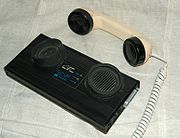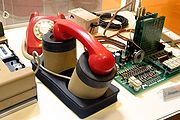
Acoustic coupler
Encyclopedia


Telecommunication
Telecommunication is the transmission of information over significant distances to communicate. In earlier times, telecommunications involved the use of visual signals, such as beacons, smoke signals, semaphore telegraphs, signal flags, and optical heliographs, or audio messages via coded...
s, the term acoustic coupler has the following meanings:
- An interfaceNetwork interfaceNetwork interface may refer to:* Network interface controller, the device a computer uses to connect to a computer network* Network interface device, a demarcation point for a telephone network...
device for couplingCoupling (electronics)In electronics and telecommunication, coupling is the desirable or undesirable transfer of energy from one medium, such as a metallic wire or an optical fiber, to another medium, including fortuitous transfer....
electrical signals by acoustical means—usually into and out of a telephoneTelephoneThe telephone , colloquially referred to as a phone, is a telecommunications device that transmits and receives sounds, usually the human voice. Telephones are a point-to-point communication system whose most basic function is to allow two people separated by large distances to talk to each other...
instrument. - A terminalTerminal (telecommunication)In the context of telecommunications, a terminal is a device which is capable of communicating over a line. Examples of terminals are telephones, fax machines, and network devices - printers and workstations....
device used to link dataDataThe term data refers to qualitative or quantitative attributes of a variable or set of variables. Data are typically the results of measurements and can be the basis of graphs, images, or observations of a set of variables. Data are often viewed as the lowest level of abstraction from which...
terminals and radioRadioRadio is the transmission of signals through free space by modulation of electromagnetic waves with frequencies below those of visible light. Electromagnetic radiation travels by means of oscillating electromagnetic fields that pass through the air and the vacuum of space...
sets with the telephone networkPublic switched telephone networkThe public switched telephone network is the network of the world's public circuit-switched telephone networks. It consists of telephone lines, fiber optic cables, microwave transmission links, cellular networks, communications satellites, and undersea telephone cables, all inter-connected by...
.
The link is achieved through acoustic
Acoustics
Acoustics is the interdisciplinary science that deals with the study of all mechanical waves in gases, liquids, and solids including vibration, sound, ultrasound and infrasound. A scientist who works in the field of acoustics is an acoustician while someone working in the field of acoustics...
(sound) signals rather than through direct electrical connection
Electrical connection
An electrical connection between discrete points allows the flow of electrons . A pair of connections is needed for a circuit.Between points with a low voltage difference, direct current can be controlled by a switch...
.
History and applications
Prior to its breakupBell System divestiture
The Bell System divestiture, or the breakup of AT&T, was initiated by the filing in 1974 by the U.S. Department of Justice of an antitrust lawsuit against AT&T. The case, United States v...
in 1984, Bell System
Bell System
The Bell System was the American Bell Telephone Company and then, subsequently, AT&T led system which provided telephone services to much of the United States and Canada from 1877 to 1984, at various times as a monopoly. In 1984, the company was broken up into separate companies, by a U.S...
's monopoly over telephony
Telephony
In telecommunications, telephony encompasses the general use of equipment to provide communication over distances, specifically by connecting telephones to each other....
in the United States allowed the company to impose strict rules on how consumers could access their network. Customers were prohibited from connecting phones not made or sold by Bell to the network, and for a long time the phone itself was owned by the phone company and leased to customers. In many households, telephones were hard-wired to wall terminals before connectors like RJ11 and BS 6312 became standardised. The telephone network was essentially a closed system
Closed system
-In physics:In thermodynamics, a closed system can exchange energy , but not matter, with its surroundings.In contrast, an isolated system cannot exchange any of heat, work, or matter with the surroundings, while an open system can exchange all of heat, work and matter.For a simple system, with...
wholly controlled and owned by Bell end-to-end. Interconnection
Interconnection
In telecommunications, interconnection is the physical linking of a carrier's network with equipment or facilities not belonging to that network...
of outside phones or other terminal equipment to the telephone system was not allowed.
It was not until a landmark court ruling regarding the Hush-A-Phone in 1956 that the use of a phone attachment (by a third party vendor) was allowed for the first time; though AT&T
AT&T
AT&T Inc. is an American multinational telecommunications corporation headquartered in Whitacre Tower, Dallas, Texas, United States. It is the largest provider of mobile telephony and fixed telephony in the United States, and is also a provider of broadband and subscription television services...
's right to regulate any device connected to the telephone system was upheld by the courts, they were instructed to cease interference towards Hush-A-Phone users. A second court decision in 1968 regarding the Carterfone
Carterfone
The Carterfone is a device invented by Thomas Carter. It manually connects a two-way mobile radio system to the public switched telephone network , making it a direct predecessor to today's autopatch....
further allowed any device not harmful to the system to be connected directly to the AT&T network. This decision enabled the proliferation of later innovations like answering machine
Answering machine
The answering machine or message machine, also known as the telephone answering machine in the UK and some Commonwealth countries) and previously known as an ansaphone, ansafone, or telephone answering device is a device for answering telephones and recording callers' messages.Unlike voicemail,...
s, fax
Fax
Fax , sometimes called telecopying, is the telephonic transmission of scanned printed material , normally to a telephone number connected to a printer or other output device...
machines, and modems.
Earlier, any third-party terminal equipment
Terminal equipment
In telecommunication, the term terminal equipment has the following meanings:* Communications equipment at either end of a communications link, used to permit the stations involved to accomplish the mission for which the link was established....
had to be acoustically, rather than electrically, connected to the phone system. Acoustic Modems or Couplers were developed around 1966, a.o.. by John Van Geen at Stanford Research Institute, that mimicked handset operations. An early commercial model was built by Livermore Data Systems in 1968. One would dial the computer system (which would have telephone company datasets) on one's phone, and when the connection was established, place the handset into the acoustic modem.
Since the handsets were all supplied by the telephone company, most had the same shape, simplifying the physical interface. A microphone and a speaker inside the modem box would pick up and transmit the signaling tones, and circuitry would convert those audio shift-key encoded frequency binary signals for an RS232 output socket. With luck one could get 300 baud (~bits/second) transmission rates, but 150 baud was more typical.
That speed was sufficient for typewriter-based terminals, as the IBM 2741, running at 147.5 baud, or a teletype, running at 110 baud.
The practical upper limit for acoustic-coupled modems was 1200-baud, first made available in 1973 by Vadic and 1977 by AT&T. It became widespread in 1985 with advent of the Hayes Smartmodem 1200A. Such devices facilitated the creation of dial-up bulletin board system
Bulletin board system
A Bulletin Board System, or BBS, is a computer system running software that allows users to connect and log in to the system using a terminal program. Once logged in, a user can perform functions such as uploading and downloading software and data, reading news and bulletins, and exchanging...
s, a forerunner of modern internet chat rooms, message boards, and e-mail
E-mail
Electronic mail, commonly known as email or e-mail, is a method of exchanging digital messages from an author to one or more recipients. Modern email operates across the Internet or other computer networks. Some early email systems required that the author and the recipient both be online at the...
.
Design
Usually, a standard telephone handset was placed into a cradle that had been engineered to fit closely (by the use of rubber seals) around the microphoneMicrophone
A microphone is an acoustic-to-electric transducer or sensor that converts sound into an electrical signal. In 1877, Emile Berliner invented the first microphone used as a telephone voice transmitter...
and earpiece of the handset. A modem would modulate a loudspeaker
Loudspeaker
A loudspeaker is an electroacoustic transducer that produces sound in response to an electrical audio signal input. Non-electrical loudspeakers were developed as accessories to telephone systems, but electronic amplification by vacuum tube made loudspeakers more generally useful...
in the cup attached to the handset's microphone, and sound from the loudspeaker in the telephone handset's earpiece would be picked up by a microphone in the cup attached to the earpiece. In this way signals could be passed in both directions.
Acoustic couplers were sensitive to external noise and depended on the widespread standardisation of the dimensions of telephone handsets. Direct electrical connections to telephone networks, once they were made legal, rapidly became the preferred method of attaching modems, and the use of acoustic couplers dwindled. Acoustic couplers are still used by people travelling in areas of the world where electrical connection to the telephone network is illegal or impractical. Many models of TDDs (Telecommunications Device for the Deaf
Telecommunications device for the deaf
A telecommunications device for the deaf is a teleprinter, an electronic device for text communication over a telephone line, that is designed for use by persons with hearing or speech difficulties...
) still have a built-in acoustic coupler, which allow more universal use with pay phones
Payphone
A payphone or pay phone is a public telephone, often located in a phone booth or a privacy hood, with pre-payment by inserting money , a credit or debit card, or a telephone card....
.
An acoustic coupler is prominently shown early in the 1983 film "WarGames
WarGames
WarGames is a 1983 American Cold War suspense/science-fiction film written by Lawrence Lasker and Walter F. Parkes and directed by John Badham. The film stars Matthew Broderick and Ally Sheedy....
", when character David Lightman (depicted by actor Matthew Broderick) places a telephone handset into the cradle of a film prop acoustic modem to accentuate the act of using telephone lines for interconnection to the developing computer networks of the period, in this case, a military command computer. Although this device was obsolete even at the time of filming, it was felt that an acoustic coupler would be easily identifiable and understood by the audience who would then know what was happening.
External links
- 1964 Livermore Data Systems Model A acoustic coupler modem surfs the web Digitronics acoustic coupler patent, January 5, 1971

